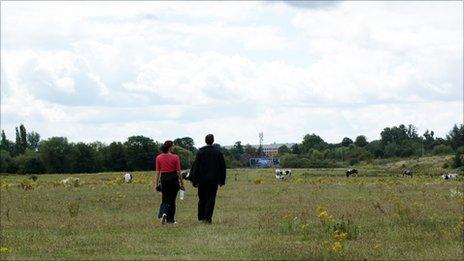New rail/road 'inland port' to boost East Mids economy?
- Published
- comments
Opponents of the plans said it will bring more road traffic to the area
They're a feature of many motorway junctions these days; I'm referring to the enormous warehouses that are the new growth industry of UK plc.
The latest is planned for farmland by junction 24 of the M1 near East Midlands Airport.
But this development is more ambitious than most. The 6m sq ft site would be served by a new railway.
Freight brought into the UK via Felixstowe, Hull or the Channel ports would arrive into the proposed distribution centre and the economic heart of the East Midlands region by rail, rather than road.
Some residents near the airport aren't convinced. They've raised concerns during consultation meetings with local politicians.
But Roxhill Developments of Rugby, the company behind the project, is upbeat. One of its directors, Kate Bedson, told me about its rail interchange ambitions.
"This site will act like an inland port for the goods that are coming in from oversees and Europe," she said.
"Our evidence suggests it should generate 6,000 jobs."
An existing freight rail line linking Nottingham and Birmingham would be extended to the proposed site.
The developers also talk up the benefits for M1 motorists.
"Junction 24 is very important for the region, but it's almost up to capacity," she added.
"There'll be improvements to M1 junctions in the area and a new bypass for Kegworth. All of this will ease the road network and make it easier to get freight here on the railway," added Ms Bedson.
And that sort of talk is attracting influential backing.
"It's an opportunity for us," said Martin Traynor, chief executive of the Leicestershire Chamber of Commerce.
"This scheme will link both rail and air transport at East Midlands Airport. It already handles the second largest amount of air freight in the UK and the opportunity of adding rail to it will be of huge strategic advantage for the region."
Conservative MP for Leicestershire North West, Andrew Bridgen, has a dilemma weighing the concerns of local residents and the project's economic potential.
"It would put over £10m of business rates into the local council. We also need jobs and the investment. That's a major factor," said the MP.
At a time of recession and a lack of employment opportunities, the prospect of 6,000 new jobs, you would have thought, would be welcomed with open arms. But not in the villages of Lockington and Hemington, which could have the rail freight interchange on their doorstep.
"I don't think for a minute there'll be 6,000 new jobs," said Hemington parish councillor Toni Harrington
"Unemployment here is very low, so there's little benefit for us there. But there'll be 6,000 people in their cars coming here and we are already under strain with one of the busiest motorway junctions in the country," she added.
Another villager opposed to the scheme is Peter Hill.
"We'll be completely ring-fenced by a railway system and with continual 24/7 freight traffic movement. The noise and light pollution will be unacceptable," he told me.
The government wants a national network of rail interchanges like this to take more freight off the roads.
Indeed, Transport Secretary Justine Greening says the government is taking measures to "unblock" obstacles. By that she means using planning powers to approve transport infrastructure schemes deemed to be of national significance.
"I'm a supporter of the government's policy for rail interchanges. It'll help to get freight off the road. It's good for the environment and good for business," added Andrew Bridgen.
The proposed junction 24 rail freight interchange is set to be an unwelcome neighbour for residents. They say the go-ahead is not yet a done deal. But the economic case may prove too powerful and persuasive for government ministers to ignore.
- Published8 September 2011
